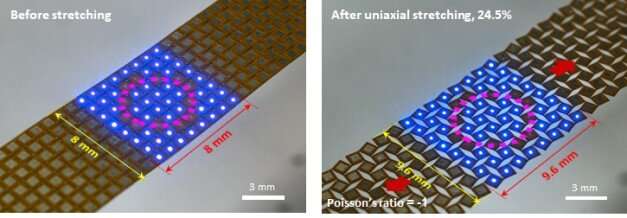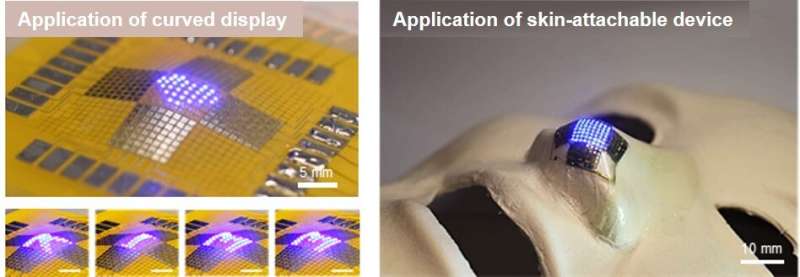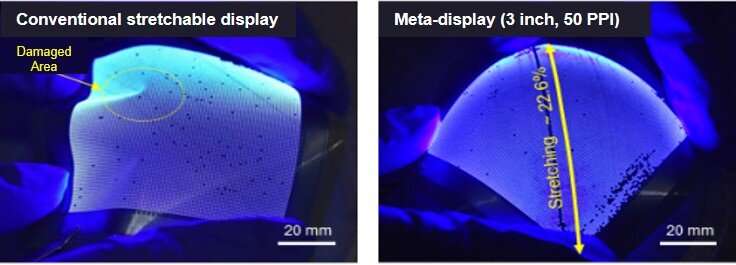by National Research Council of Science & Technology

When the meta-display is stretched lengthwise, it is also stretched widthwise at the same ratio, so that the displayed image can be expanded without distortion. Credit: The Korea Institute of Machinery and Materials (KIMM)
The Korea Institute of Machinery and Materials (KIMM) has successfully developed the first stretchable meta-display technology that can be stretched up to 25% without image distortion. The results are published in Advanced Functional Materials. The Department of Nano-Mechanics at KIMM has been researching the field of micro-LED transfer technology since 2008. This was achieved by using the design and manufacturing technology of metamaterials with unique mechanical properties that do not exist in nature.
Most stretchable materials in nature, such as rubber, demonstrate shrinkage in width when stretched lengthwise, thus resulting in image distortion. This was also the same in cases of the rubber-based stretchable displays.
The KIMM research team applied mechanical metamaterials with a negative Poisson's ratio to a circuit board. The Poisson's ratio refers to the ratio at which the width of material shrinks when it is stretched lengthwise. When a mechanical metamaterial with a Poisson's ratio of -1 is stretched lengthwise, it demonstrates the effect of stretching at the same ratio widthwise. Thus, a display using such materials is characterized by images that are not distorted.
In developing this new meta-display manufacturing technology, the team applied mechanical metamaterial designs and manufacturing technology to the world's leading large-area micro-LED roll transfer technology. Based on the successful results of this project, the research team plans to conduct follow-up research on micro-LED displays for ultra-realistic metaverses.

The manufacturing of curved displays that use meta-displays to display images and devices that can be attached to the skin. Credit: The Korea Institute of Machinery and Materials (KIMM)
Furthermore, in order to respond to the growing mini-LED and graphene industries, the team has established research institute spin-off company, YTS Micro-Tech and MCK-Tech to promote the practical use of these new technologies.

A 3-inch meta-display and a conventional stretchable display are attached to a hemispherical surface with a radius of 80 cm. The conventional stretchable display shows wrinkles and creases occur, but the meta-display is attached smoothly without any damage. Credit: The Korea Institute of Machinery and Materials (KIMM)
Dr. Bongkyun Jang stated that his team has solved the fundamental issue of image distortion in stretchable displays by using meta-structures, and he and his team will continue to pursue the commercialization of meta-display technologies, so that they can be applied to various electronic products in the future.
The newly developed flexible meta-display technology is expected to contribute to the diversification of platforms for mobile electronic devices, such as mobile phones and tablets. Such displays can also adhere to the skin of the human body without any wrinkles, with applications in the fields of medical devices, beauty and healthcare.
More information: Bongkyun Jang et al, Auxetic Meta‐Display: Stretchable Display without Image Distortion, Advanced Functional Materials (2022). DOI: 10.1002/adfm.202113299
Journal information: Advanced Functional Materials
2022 Micro LED Self-Emissive Display Trends and Analysis on Suppliers’ Strategies
Release Date: 31 May 2022 / 30 November 2022
Language: Traditional Chinese / English
Format: PDF
|
If you would like to know more details , please contact:
|





 CN
TW
EN
CN
TW
EN








